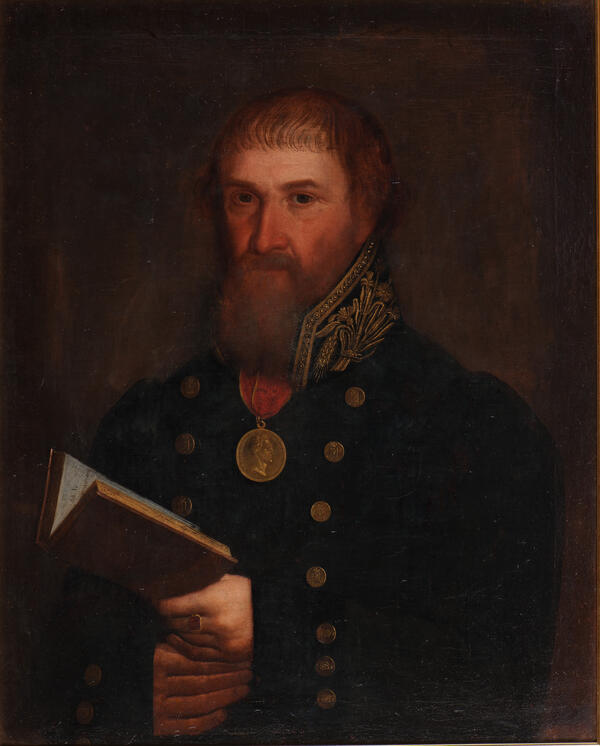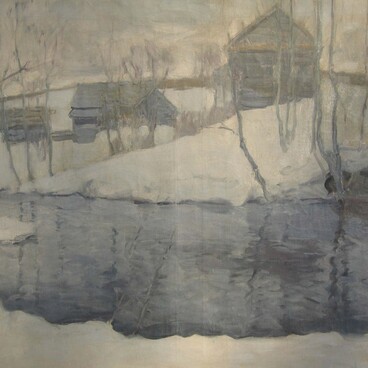The portrait by an unknown artist depicts a Zaraysk merchant Fyodor Yegorovich Tepitsyn. He served as the mayor of Zaraysk.
The position of the mayor was first introduced by the manifesto of Catherine II in 1766. It was assumed that the one elected to the post would represent the opinion of the townspeople in the Commission for composing a draft of the new Law Code. Since 1771, the connection of the mayor with the Commission was abolished, and the position itself remained and became permanent. The mayor began to be elected regularly every two years. Men over 30 years old could participate in the elections, if they had real estate, craft or bargaining in the city. The mayor became the mediator between the townspeople and state institutions, as well as the head of the city government.
In a portrait from the Zaraysk Kremlin collection we see a middle-aged man with reddish hair, mustache and beard. His gaze is focused and serious. A large gold medal ‘For Worthwhile’ is around Tepitsyn’s neck. Such medals, made of gold or silver, were awarded to merchants for various merits: donating large sums to charity or helping the government. Sewing on a uniform’s collar in a shape of ears of corn and cornflowers shows the belonging to the Ministry of Internal Affairs.
The portrait was created in the middle of the 19th century, when Zaraysk belonged to the Ryazan province. Therefore, Fyodor Tepitsyn is depicted in the uniform of the mayor, where the crest of the province is depicted on gold buttons. The unknown author pedantically depicted the crest on each button.
In merchant families, it was important not only to show the level of their wealth, but also to demonstrate education, especially for men. The merchant holds a book in his hands. It seems that Tepitsyn looked up from reading for a second to look at the viewer. The book in the hand of one of the ‘city fathers’ emphasizes his erudition and education.
Tepitsyn’s portrait is paired; there is also a portrait of his wife, E.P. Tepitsyna, in the Zaraysk Kremlin collection. In the merchant sphere, such a pair portrait was called “druzhka” (“a friend”).
The position of the mayor was first introduced by the manifesto of Catherine II in 1766. It was assumed that the one elected to the post would represent the opinion of the townspeople in the Commission for composing a draft of the new Law Code. Since 1771, the connection of the mayor with the Commission was abolished, and the position itself remained and became permanent. The mayor began to be elected regularly every two years. Men over 30 years old could participate in the elections, if they had real estate, craft or bargaining in the city. The mayor became the mediator between the townspeople and state institutions, as well as the head of the city government.
In a portrait from the Zaraysk Kremlin collection we see a middle-aged man with reddish hair, mustache and beard. His gaze is focused and serious. A large gold medal ‘For Worthwhile’ is around Tepitsyn’s neck. Such medals, made of gold or silver, were awarded to merchants for various merits: donating large sums to charity or helping the government. Sewing on a uniform’s collar in a shape of ears of corn and cornflowers shows the belonging to the Ministry of Internal Affairs.
The portrait was created in the middle of the 19th century, when Zaraysk belonged to the Ryazan province. Therefore, Fyodor Tepitsyn is depicted in the uniform of the mayor, where the crest of the province is depicted on gold buttons. The unknown author pedantically depicted the crest on each button.
In merchant families, it was important not only to show the level of their wealth, but also to demonstrate education, especially for men. The merchant holds a book in his hands. It seems that Tepitsyn looked up from reading for a second to look at the viewer. The book in the hand of one of the ‘city fathers’ emphasizes his erudition and education.
Tepitsyn’s portrait is paired; there is also a portrait of his wife, E.P. Tepitsyna, in the Zaraysk Kremlin collection. In the merchant sphere, such a pair portrait was called “druzhka” (“a friend”).



